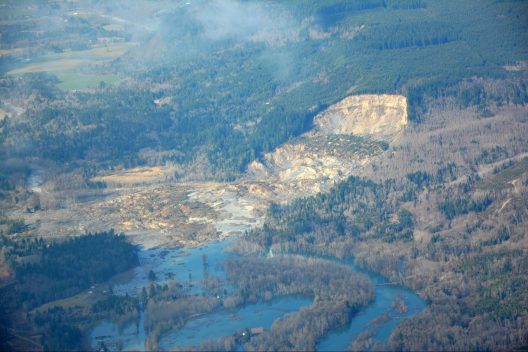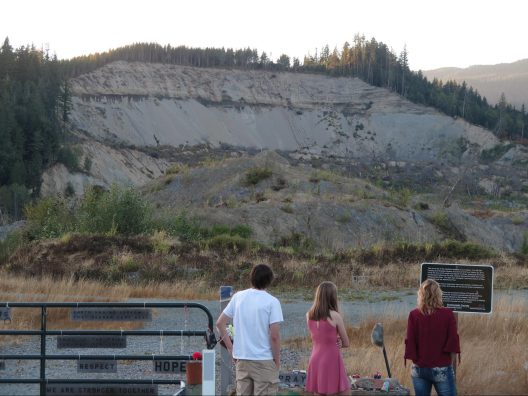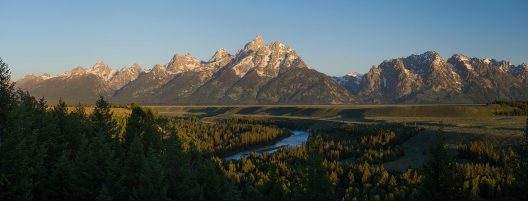The Art of Restoration: Connecting to Nature as We Mend Our Natural Landscapes
Early in 2014, March 22nd started as a day just like any other. While Seattle buzzed with city life some 50 miles away, it was a sleepy Saturday morning in the small rural town of Oso, Washington. And for Steelhead Haven — a tiny sub-community just a few miles away, tucked in a beautiful valley along the mighty Stillaguamish River — that morning was even more peaceful.
Until it wasn’t.

The clock struck 10:37 AM, and in the blink of an eye, nature wreaked havoc. Within a minute, a half square mile of land was covered with 18 million tons of sand and clay. The Stillaguamish River was effectively dammed, the town of Darrington became nearly inaccessible, and the lives of 43 people were tragically lost. Scientists with the U.S. Geological Survey have spent countless hours piecing together the mechanics of this powerful landslide and its incredibly high mobility. The most likely explanation is that heavy seasonal precipitation led to destabilization when the soil simply couldn’t hold any more water. USGS scientists continue to monitor the area, especially since it remains landslide-prone.
Scientific monitoring and analysis of past events are key components to understanding our natural world. Landslides are a part of that natural cycle of an ecosystem, but what happens when altered landscapes — whether from natural disasters like the Oso Mudslide or anthropogenic activities — put economic resources, cultural values, and even human lives at risk? Some manner of recourse must be available to help restore places to a less precarious state.
Those solutions exist within the field of restoration ecology. Restoration ecology is nothing new; Indigenous peoples have been restoring ecosystems since time immemorial, and many Native practices and perspectives have guided restoration efforts in the United States in recent years. The field is incredibly complex, drawing on ecological concepts like succession, community assemblage, population genetics, ecosystem function, and more. It’s almost like a painting: choosing your canvas and type of paint is essential, but it’s the colors and brushstrokes that give it a unique character. Knowledge, creativity, and even trial and error play key parts in finding that delicate balance of contrast and color.
Enough about paint and technicalities. Let’s look at the big picture.
What is ecological restoration?
Broadly, ecological restoration aims to help a damaged or degraded ecosystem begin to recover or even recover faster. Of course, this is extremely challenging — and, at times, frankly impossible — but “restoration” is often used to refer to a set of goals that progress toward restoration. For example, improvement (or habitat enhancement) strengthens the habitat quality but does not restore all ecosystem functions, and rehabilitation improves some aspects of an ecosystem but not all of the components. Most often, what we refer to as “restoration” falls within the categories of improvement or rehabilitation.
You might be thinking that restoration would be a lengthy process, and you’d be right. There are a lot of baselines to establish prior to starting a restoration project, and it all starts with clearly defining a goal that will inform the entire process. Then comes the data collection of numerous parameters, the meticulous planning, the securing of permits and funds and labor, ideally the consultation with local Tribes alongside other community interests and stakeholders (though it’s worth noting this part doesn’t always happen)… the list goes on. There are no “buts” about it being a massive undertaking.
Okay, maybe there is one “but”: restoration works. The San Francisco Bay has had great success restoring tidal marshlands, which now support local fisheries and provide more effective coastline stabilization. The World Wildlife Fund tackled an ambitious forest restoration project in Thailand, providing Thai farmers with more financial security and the tools to practice farming more sustainably. And restoration extends beyond landscapes: WWF has worked night and day to get great panda numbers up and out of the “endangered” range.
Restoration comes in all shapes and sizes
Restoration comes in countless colors, and no two projects are the same. There are so many questions to ask and answer. How do we make decisions to change landscapes? How do we decide to restore something? What does restoration even look like? When and how you do it all depends on not only the ecosystem you’re trying to heal, but also the surrounding community’s values and needs, the particular region, and so many other factors.
I had always thought of restoration as some lofty goal that happened once in a blue moon. That is, until I went to visit active restoration sites like the Stillaguamish Tribe’s Zis a ba site, or learned about scientists at the Mote Marine Laboratory establishing lab-raised corals on the Florida Keys. Some restoration comes after anthropogenic activities have degraded habitat, like cleared and developed floodplains or shoreline armoring for key salmon habitats. Other projects focus on preventing future disasters, like the Natural Capital Project’s integrated coastal zone management plan for Belize that works holistically to prepare coastal communities and their local environments for coastal hazards like king tides.
Restoration can also be a response to a completely natural event that severely impacts human life, such as a landslide. There is a fine balance between the ecological need to let Mother Nature do what comes naturally and the human need to find ways to recover from a disaster.

Restoration isn’t perfect. The knowledge and practices that we have can’t return ecosystems to their prior state, nor can they bring back the lives that were lost in the Oso Mudslide of 2014. But it’s always evolving as we learn more about how the components of an ecosystem work together to create the wonder that is nature.
Why should we restore landscapes?
If restoration isn’t perfect, is it worth it? Absolutely — and what’s more, it’s necessary. There is a lot that healthy ecosystems offer us as humans: clean air to breathe, clean water to drink, food to eat, ways to earn a living, and beautiful places to enjoy. Many would also argue that, as humans, it’s our responsibility to heal the places that we’ve damaged through our own actions, especially when those places are home primarily to marginalized communities. This is the foundation of stewardship. After all, not taking good care of our home wouldn’t leave us with much of a home to live in. In the words of some of my favorite musicians (and, of course, many other writers and activists), there is no Planet B. Restoration is one key way to getting us back on track and headed toward a sustainable future.
Aside from the climate anxiety that a lot of us feel these days, there is a more encouraging, peaceful way to understand why we should restore landscapes: it can mend our connection to nature. Jason Griffith, the environmental manager for the Stillaguamish Tribe, spoke to my stream and watershed restoration class about the long hours he had spent out at the Zis a ba tidal marsh, taking measurements, talking to neighbors, and even getting buzzed by an unhappy mama hawk a time or two. His connection to that site was palpable and contagious — it made me want to know a landscape that well.

For a lot of my life, I couldn’t seem to reconcile the science of nature with the sacredness of nature. Learning more about restoration has brought me closer to understanding where these two intersect. It’s even begun to convince me that one cannot exist without the other, just like the checks and balances that exist within an ecosystem. Restoration is a complex process of healing natural connections, human connections, or both. Although a place like Steelhead Haven will never be the same, maybe we can take solace in restoring what we can and honoring what was lost. Maybe when we help to heal Mother Nature, we heal, too.